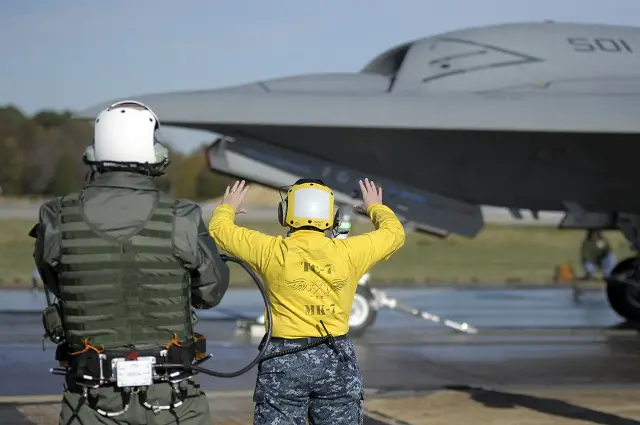Breaking news
Northrop Grumman, U.S. Navy Demonstrate Precision, Wireless Ground Handling of X-47B UCAS.
| 2012
| |
|||
| a | |||
Naval
Forces News - USA |
|||
Northrop
Grumman, U.S. Navy Demonstrate Precision, Wireless Ground Handling of
X-47B UCAS |
|||
Northrop
Grumman Corporation and the U.S. Navy have taken a first critical step
toward demonstrating that the X-47B
Unmanned Combat Air System (UCAS) demonstrator can be maneuvered
safely and wirelessly on the crowded deck of an aircraft carrier. In early November, the team successfully completed its first shore-based trials of a new wireless, handheld device called a Control Display Unit (CDU). Developed by Northrop Grumman, the device will allow deck operators to maneuver the X-47B by remote control on the carrier deck. |
|||
 (Picture: Northrop Grumman Corp.) |
|||
The
team demonstrated the CDU's ability to control the X-47B's engine thrust;
to roll the aircraft forward, brake and stop; to use its nose wheel
steering to execute tight, precision turns; and to maneuver the aircraft
efficiently into a catapult or out of the landing area following a mock
carrier landing. Northrop Grumman is the Navy's prime contractor for the UCAS Carrier Demonstration (UCAS-D) program. "The CDU is fundamental to integrating the X-47B seamlessly into carrier deck operations," said Daryl Martis, Northrop Grumman's UCAS-D test director. "It will allow us to move the aircraft quickly and precisely into the catapult for launch, or out of the landing area following recovery. Both of these activities are essential to maintaining the rhythm of the flight deck." |
|||
 (Picture: Northrop Grumman Corp.) |
|||
In practice, a deck operator will work in tandem with the flight deck
director – aka a "yellow shirt" – to move the
X-47B via the CDU to a designated flight deck location. Standing in
front of the aircraft, the director will use traditional hand signals
to indicate how, when and where the aircraft should move, the same way
he would communicate with a pilot in a manned aircraft. The deck operator
will stand behind the director and use the CDU to duplicate the director's
instructions as digital commands to the aircraft. According to Martis, the CDU will help streamline and, in fact, enable many of the flight test operations required for UCAS-D shore-based carrier suitability testing. "Instead of towing the aircraft out to the flight line, we can now start the X-47B outside its hangar, then use the CDU to taxi it out to the runway, or into a catapult for launch," he said. "Use of the CDU is the most time-efficient way to move the X-47B into the catapult or disengage it from the arresting gear after landing." The UCAS-D program plans to conduct its first shore-based catapults of X-47B aircraft later this month. That testing will be followed by hoisting an X-47B aboard an aircraft carrier, and using it to validate the performance of the CDU in an actual carrier environment. In 2013, the program plans to demonstrate the ability of an X-47B to safely operate from a Navy aircraft carrier, including launch, recovery, and air traffic control operations. The program also plans to mature technologies required for potential future Navy unmanned air system programs. For the latest X-47B news and information, please visit www.as.northropgrumman.com/products/nucasx47b/. Northrop Grumman's UCAS-D industry team includes GKN Aerospace, Lockheed Martin, Pratt & Whitney, Eaton, General Electric, UTC Aerospace Systems, Dell, Honeywell, Moog, Wind River, Parker Aerospace and Rockwell Collins. Link to X-47B UCAS-D datasheet |


























